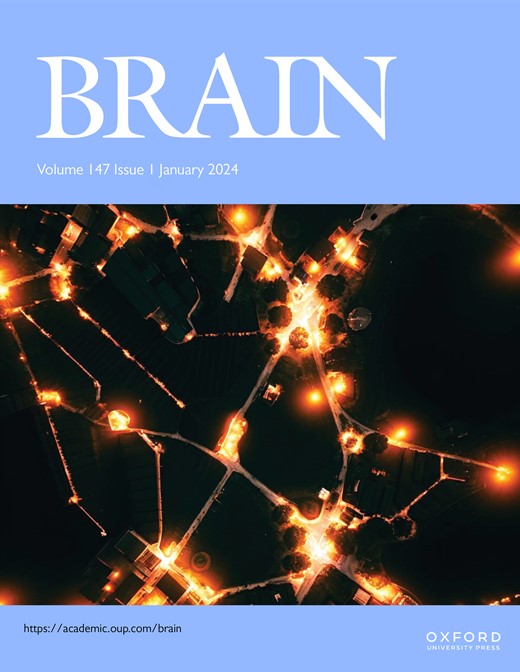Imposter in the brain: aetiological, clinical and neuroimaging characteristics of Capgras syndrome
IF 11.7
1区 医学
Q1 CLINICAL NEUROLOGY
引用次数: 0
Abstract
Capgras syndrome is a delusional misidentification syndrome characterized by the recurrent belief that someone, usually a family member, has been replaced by an impostor. Although described over a century ago, its etiology, clinical features, and neuroimaging characteristics remain poorly understood due to its rarity. This study aimed to clarify these aspects through the analysis of a large cohort and to explore its clinical implications and underlying mechanisms. We conducted a retrospective cohort study by reviewing medical records of patients diagnosed with Capgras syndrome at the Mayo Clinic (Rochester, Minnesota) over a 28-year period (January 1995–December 2022). Clinical, neuropathological, and neuroimaging data were analyzed. A total of 204 patients were included (median age at onset: 73 years; 44% female). Twelve patients underwent neuropathological examination, all of whom exhibited α-synuclein pathology, including one patient with a clinical diagnosis of Alzheimer’s disease (AD). Regarding clinical diagnoses, neurodegenerative diseases were the most common (69%, n=140), with dementia with Lewy bodies (DLB) being predominant (58%, n=118), followed by mixed etiologies (“two-hits”) (18%, n=36) and AD (10%, n=21). Psychotic disorders accounted for 9% (n=18) of cases. No case was attributed to a single stroke, although 9% (n=19) involved coexisting cerebrovascular disease in the context of AD or DLB. In DLB, the timing of Capgras syndrome onset varied: it occurred later than cognitive decline and core clinical features (e.g., visual hallucinations, fluctuating cognition, parkinsonism) in both DLB and mild cognitive impairment (MCI)-onset prodromal DLB, but earlier in psychiatric-onset prodromal DLB. In both DLB and AD, Capgras syndrome typically targeted a single spouse, whereas in psychotic disorders, it often involved multiple, non-spousal targets. Depression or anxiety was present in 55% (n=112). Capgras syndrome worsened in the evening or at night (87%, n=45/52), suggesting a link to negative affective states. Among 82 patients with DLB and AD treated with cholinesterase inhibitors, 15% (n=12) showed symptomatic improvement. Neuroimaging with MRI and 18F-fluorodeoxyglucose-PET revealed widespread bilateral cortical involvement and prominent right frontal dysfunction in DLB and AD. Capgras syndrome is associated with DLB and could serve as a potential early diagnostic clue. Recognizing its phenomenological features—the number and type of targeted individuals—can help differentiate between neurodegenerative and psychiatric etiologies. In neurodegenerative diseases, Capgras syndrome may reflect a multifactorial, dynamic process, driven by widespread bilateral cortical dysfunction (particularly involving the right frontal lobe), and psychological factors. Thus, a combined approach involving pharmacological and non-pharmacological interventions may offer effective management strategies.脑内冒名顶替者:Capgras综合征的病因学、临床和神经影像学特征
卡普格拉综合征是一种妄想性误认综合征,其特征是反复相信某人(通常是家庭成员)被冒名顶替者取代。尽管早在一个多世纪前就有描述,但由于其罕见,其病因、临床特征和神经影像学特征仍然知之甚少。本研究旨在通过大队列分析来澄清这些方面,并探讨其临床意义和潜在机制。我们通过回顾Mayo Clinic (Rochester, Minnesota) 28年间(1995年1月至2022年12月)诊断为Capgras综合征的患者的医疗记录,进行了一项回顾性队列研究。分析临床、神经病理和神经影像学资料。共纳入204例患者(中位发病年龄:73岁;44%为女性)。12例患者行神经病理学检查,均表现为α-突触核蛋白病理,其中1例临床诊断为阿尔茨海默病(AD)。在临床诊断方面,神经退行性疾病最常见(69%,n=140),以伴路易体痴呆(DLB)为主(58%,n=118),其次是混合病因(“双发”)(18%,n=36)和AD (10%, n=21)。精神障碍占9% (n=18)。虽然9% (n=19)的患者在AD或DLB的情况下伴有脑血管疾病,但没有病例归因于单一中风。在DLB中,Capgras综合征的发病时间各不相同:在DLB和轻度认知障碍(MCI)发作的DLB前驱中,Capgras综合征的发病时间晚于认知能力下降和核心临床特征(如视觉幻觉、认知波动、帕金森病),但在精神病发作的DLB前驱中,Capgras综合征的发病时间早于认知能力下降和核心临床特征(如视觉幻觉、认知波动、帕金森病)。在DLB和AD中,Capgras综合征通常针对单个配偶,而在精神疾病中,它通常涉及多个非配偶目标。55%的患者存在抑郁或焦虑(n=112)。Capgras综合征在傍晚或夜间加重(87%,n=45/52),表明与消极情感状态有关。在接受胆碱酯酶抑制剂治疗的82例DLB和AD患者中,15% (n=12)出现症状改善。MRI和18f -氟脱氧葡萄糖- pet神经影像学显示DLB和AD患者双侧皮质广泛受累,右侧额叶功能障碍突出。Capgras综合征与DLB相关,可作为潜在的早期诊断线索。认识其现象学特征——目标个体的数量和类型——有助于区分神经退行性疾病和精神疾病的病因。在神经退行性疾病中,Capgras综合征可能反映了一个多因素的动态过程,由广泛的双侧皮质功能障碍(特别是涉及右额叶)和心理因素驱动。因此,包括药理学和非药理学干预的联合方法可能提供有效的管理策略。
本文章由计算机程序翻译,如有差异,请以英文原文为准。
求助全文
约1分钟内获得全文
求助全文
来源期刊

Brain
医学-临床神经学
CiteScore
20.30
自引率
4.10%
发文量
458
审稿时长
3-6 weeks
期刊介绍:
Brain, a journal focused on clinical neurology and translational neuroscience, has been publishing landmark papers since 1878. The journal aims to expand its scope by including studies that shed light on disease mechanisms and conducting innovative clinical trials for brain disorders. With a wide range of topics covered, the Editorial Board represents the international readership and diverse coverage of the journal. Accepted articles are promptly posted online, typically within a few weeks of acceptance. As of 2022, Brain holds an impressive impact factor of 14.5, according to the Journal Citation Reports.
 求助内容:
求助内容: 应助结果提醒方式:
应助结果提醒方式:


